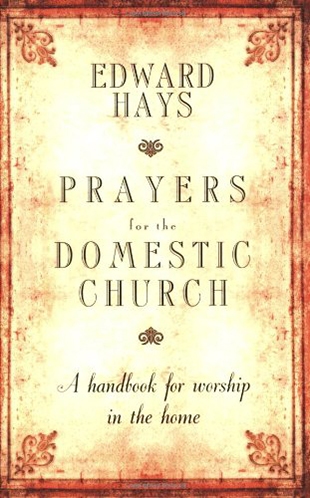"The first altar around which primitive people worshipped was the hearth, whose open-fire burned in the center of the home. The next altar-shrine was the family table where meals were celebrated and great events in the personal history of the family were remembered. The priests and the priestesses of these first rituals were the fathers and mothers of families. The grandfather (or great-grandfather) of a clan was the chief priest and held the power of blessing. Only later in history were there special persons in society whose expressed duty it was to perform the rituals and blessings of daily life. Even with the rise of an institutional priesthood and of temples outside the home, the home was held sacred and remained the primal place of prayer and worship. Each home had a shrine, its special sacred spot, where family members gathered in times of trouble and in times of rejoicing and remembering, there to bless their God with song and praise.
"Early Christianity confirmed this sense of the sacred that encircled the home. For centuries, it was in this most basic of all social structures — the home — that Christians gathered to celebrate the holy meal of the remembrance of the death and resurrection of Jesus. Again, with the passage of time, the home — along with its family-celebrants and its yearly cycle of feasts, festivals, and unique family celebrations — became eclipsed by the emergence of a great church building or cathedral. The communal church of which numerous families were a part was intended to be a gathering point, a collection of churches, we might say — and not a substitute for the domestic church, the home. Families came to the village church bringing the gifts of their domestic liturgies — their family prayers — and these were joined to prayers of other families to form the rich and inspiring prayer-mosaic of the Christian community.
"Now, in these first years of the twenty-first century, our attention is again drawn to this basic religious center, this primal domestic church that is the home. Once again, we look upon the home as a place of prayer and worship. We bring forth from the treasury of tradition the customs, rituals, blessings and prayers that find their real beauty when celebrated in the home and by the persons whose lives are directly and intimately touched by them.
"We recall again the basic truth of God's revelation, that the first holy ministers of the sacred are the father and mother of each family. Were this ancient and honored position held by all parents to once again be regarded as sacred and revered, we would not need fear a shortage of ministerial persons to service the larger family at the communal church. But for this to happen we need more than a dream, more than a simple wish that our homes become domestic churches; we need to actually begin to make them places of prayer and celebration.
"As a first step, each family must select its shrine-place, the holy gathering place for the family at times of prayer. This can be the table, or a corner of a room or simply a spot beneath a religious icon or image. No home is too small or too poor to become a domestic church. How simple are the needs: a candle, a small rug to be used as a prayer mat, a cross, an honored place where the Holy Bible is kept, a statue. . . .
"Next, a sense of awareness is necessary that makes special — that makes sacred — the common events of our daily lives. Occasions like birthdays, the purchase of a new car, the need for safety in the face of a storm, a child's first day at school, the anniversary of the death of a parent — these and countless other common events become sources of the domestic liturgy where father and mother become the prime celebrants, and other family members the concelebrants.
"Each family is a tiny nation; and, like nations, each family, each household, should have its own set of folk customs and traditions. Special foods and special activities on certain feast days combine to form a living personal family tradition. Any home that does not gift its children with a personal family tradition robs them of a birthright. These domestic traditions need to be simple but real, joyful and not superficially pious, prayerful and playful, so that they will nourish all the members of the family. Such traditions become heirlooms to be passed on from generation to generation as they are illuminated from the inside with beautiful memories and faith.
"Perhaps the greatest hurdle in making the home a center of prayer will be overcoming our embarrassment at performing these religious functions. At first we will be ill-at-ease, but the memory of this ancient prayer-custom is rooted in our inner-selves, perhaps etched forever into our DNA code. We have only to rekindle its memory to begin to treasure with reverence the power of blessing that has been asleep for so many years and that belongs to every parent — to every person.
"Awakening once again the priestly power of parents and the sacredness of the home will in no way be the cause of a lessening of reverence for the communal or local Church. Rather, we will find our communal churches once again flourishing and flowering with holiness when the gift processions at the offertory of parish Masses include the prayers and worship of each of the domestic churches whose members have come together to celebrate a communal and global celebration of gratitude. For all true worship, whether by a single family or a large parish, is never merely a worship-whirlpool pulling its members inward into themselves; rather, true worship of God fashions a glorious pinwheel of grace and peace whirling outward, touching all, to the limits of the universe and beyond."
